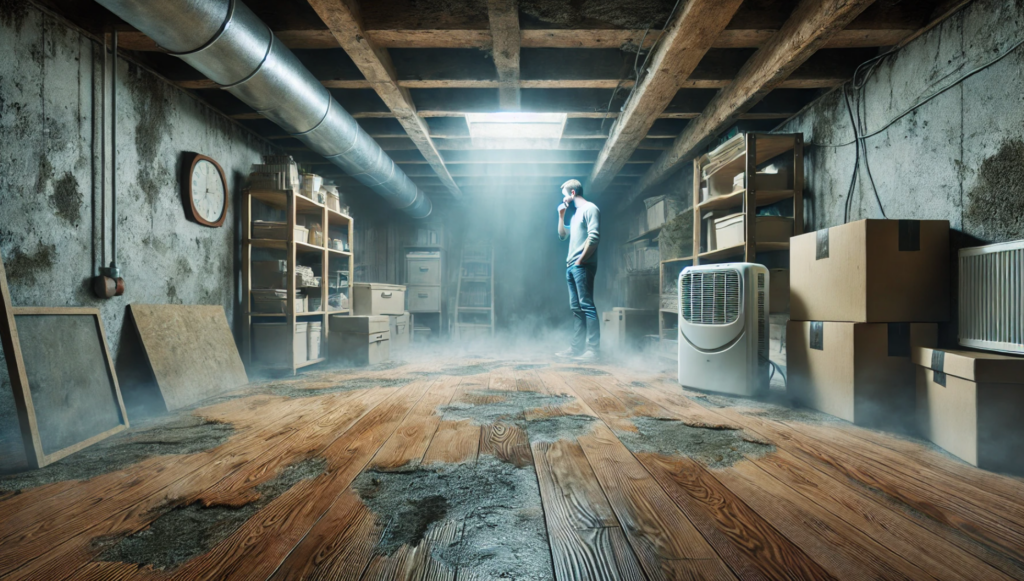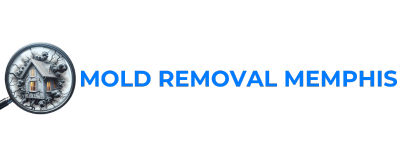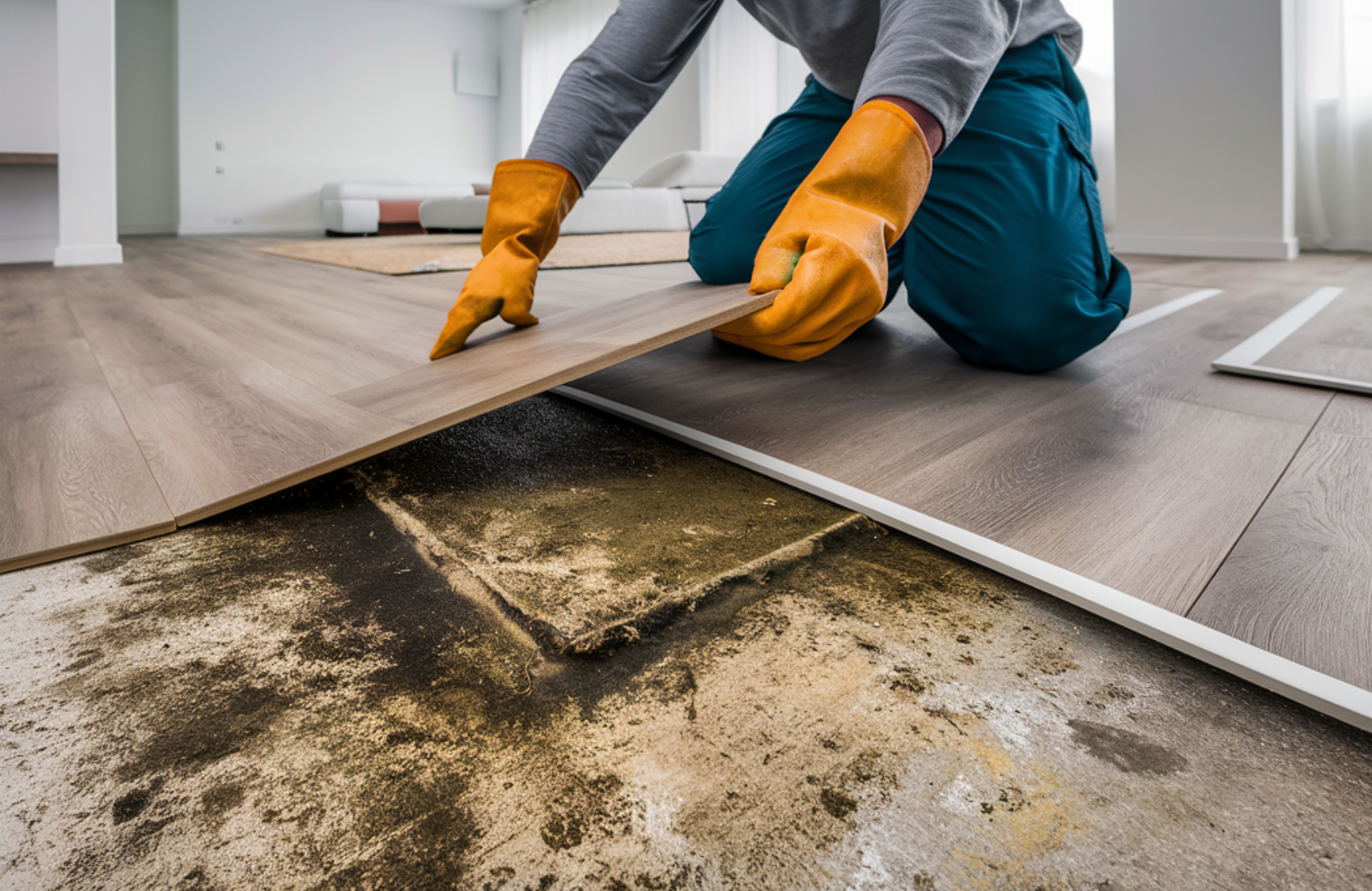Mold On Laminate Flooring: Signs, Health Risks And Removal Tips
TL;DR: Mold under laminate flooring often develops due to trapped moisture, with humidity levels above 65% posing a significant risk. Common signs include musty odors, discoloration on boards’ edges, and white or black mold spots visible at joints. Causes range from water leaks and poor ventilation to inadequate underlayment. To address mold under laminate, remove affected boards, clean the subfloor with a 1:10 bleach-water solution, and ensure thorough drying. For newer installations (3 months old) showing edge mold, conduct an air quality test to identify spore sources. In basements, inspect wall insulation if mold appears behind baseboards. Prevention strategies include maintaining humidity below 60%, using dehumidifiers, and ensuring proper ventilation. Professional remediation costs can exceed $3,000. Consider moisture-resistant alternatives like vinyl or properly sealed concrete when replacing affected flooring. Always use vapor barriers during installation, address water damage promptly, and conduct regular inspections, especially in high-risk areas, to prevent mold growth under laminate flooring.
Mold growth under laminate flooring is a common problem for homeowners. It can cause unpleasant odors and may lead to health concerns. If you’ve found mold under your laminate flooring, you might feel worried. However, this issue can be addressed effectively. We’ll cover all the necessary information to help you manage this situation and maintain a healthy living environment. Let’s examine the details of mold growth under laminate flooring and how to handle it properly.
What Does Mold Look Like On Laminate Flooring?
Mold on laminate flooring typically manifests as discoloration, stains, or fuzzy growths in various colors, including black, white, green, gray, brown, or yellow. Common signs include black, dusty material emanating from underneath the flooring, often accompanied by a musty or smoky odor. When laminate is laid over concrete or foam underlay, mold can develop due to trapped moisture, leaks, or poor ventilation. Moreover, laminate floor is also buckled if there is mold on it.

For instance, in one case, a basement furnace room flood led to water running under a shared wall and into the laminate flooring, resulting in mold formation. After six months, a musty smell signaled the presence of mold under the laminate, which spread about 36 inches from the wall and was found on the unsealed paper edges of the laminate planks. Mold often appears in dark spots or fuzzy patches, particularly on cut edges where particle board is exposed.
Mold can grow rapidly in areas with high humidity (around 65%) and poor ventilation, as seen in another case where white mold spots developed on the laminate joints close to the walls. In some scenarios, mold may form due to unnoticed leaks or water trapped between the laminate and the concrete slab, exacerbated by temperature changes.
Addressing mold under laminate flooring involves several steps: identifying and fixing the moisture source, removing affected materials, and thorough cleaning. For example, removing wet items like laminate, baseboards, door casings, underlays, and possibly drywall and insulation may be necessary. Cleaning with bleach solutions or professional products like Shockwave or hydrogen peroxide is recommended. In one case, a 20% bleach solution was used, which reduced the odor but indicated the need for a more extensive cleanup.
| Signs of Mold Under Laminate flooring | Explanation |
|---|---|
| Discoloration and Stains | Discoloration and stains are common signs of mold on laminate flooring. These can range in color from black, white, green, gray, brown, to yellow. The stains may appear in patches or spots, especially near the edges or seams of the flooring. |
| Fuzzy Growths | Mold can also manifest as fuzzy growths on the surface of laminate flooring. These growths often indicate advanced mold development and are typically found in areas with prolonged moisture exposure or water damage. |
| Musty or Smoky Odors | A persistent musty or smoky odor is a strong indicator of mold presence. This smell often permeates the room and is particularly noticeable after periods of high humidity or water damage. |
| Mold on Edges and Joints | Mold frequently appears on the cut edges and joints of laminate flooring, where the particle board is exposed. Look for dark spots or fuzzy patches along these areas, especially close to walls where moisture tends to accumulate. |
| Buckling or Warping | Buckling or warping of laminate flooring can be a sign of mold growth underneath. Water damage can cause the flooring to lift or warp, creating an ideal environment for mold to thrive. |
| Changes After Water Damage | If there has been recent flooding or water leakage, inspect the laminate flooring for any signs of mold. Mold can spread up to 36 inches from the source of moisture, often appearing on the unsealed edges of laminate planks. |
| High Humidity Areas | High humidity levels, typically around 65% or more, can contribute to mold growth on laminate flooring. Ensure proper ventilation in such areas to prevent mold development. |
| Underlying Moisture Issues | Trapped moisture between the laminate and the subfloor, particularly concrete slabs, can lead to mold growth. Perform moisture tests and address any underlying issues to prevent recurrence. |
Is Mold Under Laminate Flooring Bad?
Mold under laminate flooring is indeed bad and can pose significant health risks and structural damage to your home. The presence of mold beneath laminate flooring can even lead buckling or warping of the laminate. More importantly, mold exposure can trigger allergic reactions, respiratory issues, and other health problems, especially in individuals with compromised immune systems. Black or green mold varieties are particularly concerning as they can produce toxins.
How To Remove Mold From Laminate Flooring?
To effectively remove mold from laminate flooring, identify and eliminate moisture sources, use appropriate cleaning solutions like white vinegar or hydrogen peroxide, thoroughly dry the area, and implement preventative measures to avoid future mold growth.
Here are the steps a professional mold remediation company near you follows to remove mold from laminate flooring:
1. Identify The Source Of Moisture
Before attempting to remove mold from laminate flooring, it’s crucial to identify and address the source of moisture causing the mold growth. Potential sources include:
- Leaking pipes or appliances (e.g., dishwashers)
- Poor ventilation, especially in basements or areas with high humidity
- Water seepage through concrete subfloors
- Flooding or water damage
- Condensation due to temperature changes
Addressing the underlying moisture issue is essential to prevent mold from returning after treatment. Consider using a dehumidifier to maintain optimal humidity levels, especially in basements or areas prone to dampness.
2. Assess The Extent Of Mold Damage
Carefully inspect the affected area to determine the severity of the mold problem:
- Look for visible signs of mold on the surface of the laminate flooring
- Check for mold growth on the edges and joints of the laminate boards
- Inspect the underlayment and subfloor for signs of mold or moisture damage
- Pay attention to musty odors, which may indicate hidden mold growth
For small, localized areas of mold (less than 10 square feet), DIY removal methods may be suitable. However, for larger infestations or if you suspect extensive damage, consider consulting a professional mold remediation service. You can review our detailed mold remediation process here.
3. Prepare The Area For Mold Removal
Before beginning the mold removal process, take the following precautions:
- Wear protective gear, including gloves, goggles, and a mask to avoid exposure to mold spores
- Ensure proper ventilation by opening windows or using fans
- Remove any furniture or items from the affected area
- Cover nearby surfaces to protect them from cleaning solutions
4. Apply Appropriate Cleaning Solutions
Depending on the extent of mold growth and the type of surface, choose one of the following cleaning solutions to get rid of mold from laminate flooring:
- Bleach solution: Mix 1 part bleach with 4 parts water. Suitable for surface mold on non-porous surfaces. Apply the solution, let it sit for 5-10 minutes, then wipe clean and dry thoroughly.
- White vinegar: Use undiluted white vinegar for porous surfaces. Apply directly to the affected area, let it sit for at least an hour, then wipe clean and dry thoroughly. Vinegar is effective in killing mold and preventing regrowth.
- Hydrogen peroxide: Use a 3% hydrogen peroxide solution. Apply to the affected area, let it sit for 10-15 minutes, scrub gently if needed, then wipe clean and dry thoroughly. Effective for removing mold proteins and stubborn stains.
- Commercial mold cleaners: Products like RMR-86, Concrobium Mold Stain Remover, Benefect, or Zinsser Mold Killing Primer can be used according to manufacturer instructions. These are particularly useful for stubborn mold stains or when DIY solutions are not effective.
Note: Avoid using bleach on porous surfaces like wood, as it may not penetrate deeply enough to kill all the mold. For laminate flooring with particle board edges exposed, white vinegar or commercial mold cleaners may be more effective.
5. Remove And Replace Severely Damaged Laminate
In cases of extensive mold growth on laminate flooring or water damage:
- Remove the affected laminate boards and underlayment
- Inspect and clean the subfloor thoroughly
- Allow the area to dry completely
- Apply a mold-resistant sealant to the subfloor if necessary
- Install new underlayment and laminate flooring
Ensure proper moisture barriers are in place when reinstalling the flooring to prevent future mold issues.
How To Identify And Address Mold And Moisture Issues Before Installing Laminate Flooring?
Visible indications of mold and mildew must be addressed before proceeding with the laminate flooring installation. These visible signs include discoloration and musty odors, which can indicate the presence of mold or mildew on the subfloor, underlayment, back of the flooring, or even on the floor surface itself.
For concrete subfloors, ensure they are fully cured, dry, and smooth before installation. Wood subfloors should be dry, clean, and free of defects such as loose boards or squeaks.
Properly conditioned underlayment, like AquaBarrier II, can provide a moisture barrier and protect the flooring from potential moisture issues. If moisture is a concern, lay 6 to 8 mil polyethylene sheeting first, followed by the appropriate underlayment.
Subfloor variations should not exceed 1/8″ in 6′, and any high spots should be sanded or ground down while low spots, cracks, and depressions should be filled with Mannington MVP additive or an equivalent material.
It is also important to maintain a climate-controlled environment at the job site. The temperature should be at least 65°F, and the relative humidity should not exceed 65%. These conditions must be maintained for at least 48 hours before, during, and after installation to ensure the laminate flooring’s optimal performance.
Hire Our Professional Mold Remediation Company
For severe or recurring mold problems, professional mold remediation may be necessary:
- Professionals can conduct thorough mold testing to identify the type and extent of mold growth
- They have access to specialized equipment and products for effective mold removal
- Experts can address underlying moisture issues and provide long-term solutions
- Professional remediation ensures proper containment and disposal of mold-contaminated materials
Our expert mold removal team is equipped with the latest tools and techniques to effectively eliminate mold, safeguard your home, and maintain a healthy environment. Look at our mold removal cost calculator to estimate the cost. Don’t let mold compromise your living space—contact us today for a thorough inspection and professional mold removal services. Ensure your home remains safe and mold-free with our reliable solutions.

